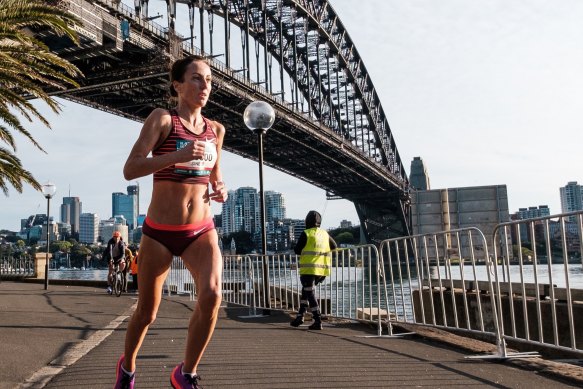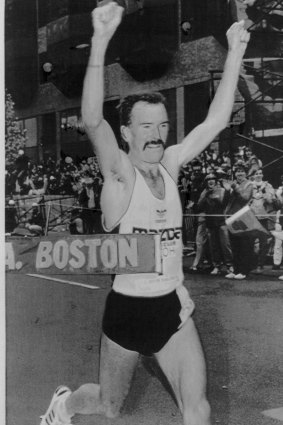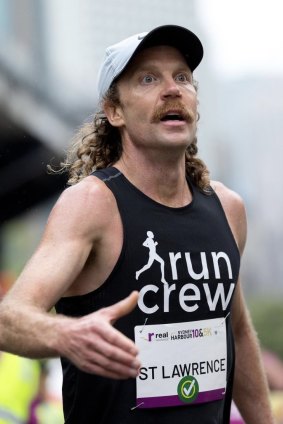This was published 1 year ago
The gear, training and fuel you need to become a better runner
By Sarah Berry
The goal of a running race is often simple, especially when we are starting out: to finish and not break ourselves in the process. As our experience grows and we want to redefine our beliefs about what we are capable of, then the goal is often to beat our own best.

Australian Marathon record holder, Sinead Diver.
With running season in full swing, there are plenty of opportunities to race against ourselves and try for a personal best, including at the City to Surf and Fred’s Big Run in August, the Sydney Marathon in September, and the Nike Melbourne Marathon Festival in October.
“When you do achieve something that is hard you do really appreciate it,” says former world champion marathoner and Olympian Rob de Castella. “There is an incredible sense of pride and self-worth and achievement. There’s nothing else like it.”
Whether you’re running five or 10 kilometres, or the half or full marathon, if you want to improve your time, there are certain areas to focus on and things to avoid during training and on race day.

Rob De Castella winning the 1986 Boston Marathon.Credit: AP
Don’t be a hero
Smashing ourselves for Strava kudos and being heroic during training sessions can result in burning ourselves out by race day and often reflects an erratic approach to training.
Instead, doing a little consistently allows our legs and cardiovascular system to adapt. Three to five sessions a week are enough, but require several key elements: a long, slow run; a short “huff and puff” session and strength training.
The long, slow weekly run gets the distance in our legs and builds endurance, while a weekly 15 to 20 minute hill or sprints session improves our cardiorespiratory fitness. This improves how quickly we recover and our capacity to go faster on race day without hitting a wall.
“Running is a mix of building up your skeletal and body strength – muscle and bones and tendons – but also your cardiorespiratory fitness,” says 66-year-old de Castella. “Both need to be in pretty good shape if you’re going to run your best.”
Running in itself is a strength exercise, he adds. “Running 10 kilometres is about 5000 mini one-legged squats on each leg with three times your body weight with every step you take.” So for someone who weighs 70 kilograms, that is a load of more than 200 kilograms with every step. “It’s an incredibly good strengthening exercise for bones, muscles and tendons and ligaments.”
Still, including a 20-minute strength and conditioning session of planks, squats and lunges each week can minimise injury risk and improve performance.
Chunk it
The biggest mistake runners make on race day is poor pacing, says Ben St Lawrence, a dual Olympian in the 10,000 metres and the founder of RunCrew, the official training partner for the Real Insurance 10km (held in Sydney last weekend).
On race day, resisting the urge to go too fast for the first few kilometres means you’re less likely to “blow up”, says the 41-year-old. “Go too hard too soon there’s no coming back from it.”

Dual Olympian and run coach, Ben St Lawrence.
For a 10-kilometre race, he suggests starting at a pace you feel you can maintain the whole race or aiming for a negative split where the second half is faster than the first half. Try holding back for the first three kilometres, picking up the pace for the second three and ramping it up for the final three to four kilometres.
During the half or full marathon, breaking it down into bite-size chunks can help it to feel less overwhelming.
Australian Marathon record holder and Sydney Marathon Ambassador, Sinead Diver, focuses on each five kilometre mark initially:
“Once I get to 15 kilometres my attention switches to the halfway mark, then the 28 kilometre mark – two-thirds of the race done. I love getting to 32 kilometres and knowing I have just over 10 to go.”
Reaching these milestones can give you a fresh boost of energy and determination, says Diver, a mother of two who started running at the age of 33 after the birth of her first son.
The 46-year-old also plans for the bad patches. “It’s all part of it. Don’t panic, stay controlled. Sometimes I like to pull back a little to compose myself, have a little breather and then aim to get back on pace. If you feel as though you’re struggling, it’s better to do this early than to continue to push.”
Gear-up
Eliud Kipchoge famously wore maximalist running shoes, which have more than 2.5 times the mid-sole volume of a standard running shoe and about 50 per cent more cushioning, when he became the first human to run a marathon under two hours.
One small study from 2022 found that running economy in a maximalist shoe was 5.7 per cent better compared with a standard shoe, which meant running about one minute and 15 seconds faster over 30-minutes.
“There’s a reason they’re so popular with the elites … they do provide a benefit,” says St Lawrence. And Diver agrees: “[They] can really help to reduce the pounding on your legs. This will help a lot in the latter stages of the race and with post-race recovery.”
Nike, Hoka, ASICS, New Balance, Adidas, On Running and Saucony all have comparable options, so it comes down to personal preference.
De Castella’s pick is the new ASICS Gel-Kayano 30. “The tech in mid-sole is leaps and bounds ahead… the cushioning and support and rebound make training more enjoyable…and makes running more efficient,” he says. “I look back at the shoes I used to run in and wonder how I ever managed to do what I did.”
As for the arm compression sleeves Kipchoge wore during his world-record setting run at the Berlin marathon in 2022, there’s little evidence they make much difference, although some research suggests they may reduce the perception of muscle soreness and pain.
St Lawrence suspects, mostly, they are a fashion statement, but even if certain gear makes us feel good or does provide benefit, he says it can’t make up for good training and nutrition.
Fuel yourself
Mick Chapman, an endurance athlete and nutritionist who has worked with a range of world championship athletes, as well as the Red Bull Defiance teams, suggests carbohydrate-rich meals that are low in fibre and saturated fat in the lead up to the race.
“Carbohydrate loading can be utilised for anything up to 72 hours prior to the race, so it’s good for people to be thinking about during race week,” he says.
St Lawrence prefers a rice-based meal the night before, with coffee and mashed banana on toast the morning of a race. Diver takes a similar approach. “The stomach is under a lot of strain on race day, so lots of plain food works best for me,” she says. “I’m also carb loading two days prior, so this usually consists of rice, plain cereal, bread, and bagels. I still like to include meat and veg but in smaller quantities.”
During a 10 kilometre there’s no need for nutrients beyond hydration; in a half-marathon, runners don’t need more than one or two gels mid-race; in a full marathon athletes need between three and eight gels across the 42 kilometres or one every 30 to 40 minutes.
The brand comes down to preference. Chapman prefers Maurten gels, while St Lawrence uses Gu. Both take a mix of uncaffeinated and – towards the end of the race – caffeinated gels.
“Nutrition and hydration in the race is the concept of your current self looking after your future self,” Chapman says. “You’re in trouble if you wait to hit the wall and then try and catch up with nutrition intake.”
Know your ‘why’
Diver says marathons have taught her a lot. “It’s without doubt my favourite distance, but it can be so cruel sometimes. If you try to rush it or underestimate it – it will chew you up.”
Respecting the race and understanding why you are doing it can be key to making it through those moments. “At the 30 kilometre mark you hit the wall and you still have 12 to go,” says de Castella. “You say ‘why am I doing this?’ and you’ve got to have a really strong ‘why’.”
For him, the ‘why’ was to be the best in the world, but there are other equally valid reasons. For the runners he trains through the Indigenous Marathon Foundation, it might be to be a positive role model for their kids; to change the health trajectory of their family or to realise their own strength in the face of life challenges.
“If you can identify your ‘why’ it becomes a superpower that you can tap into to push you through when it gets hard.”
Make the most of your health, relationships, fitness and nutrition with our Live Well newsletter. Get it in your inbox every Monday.